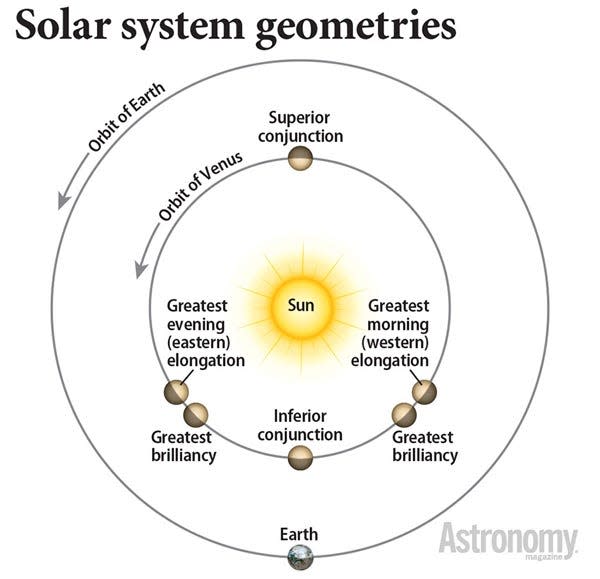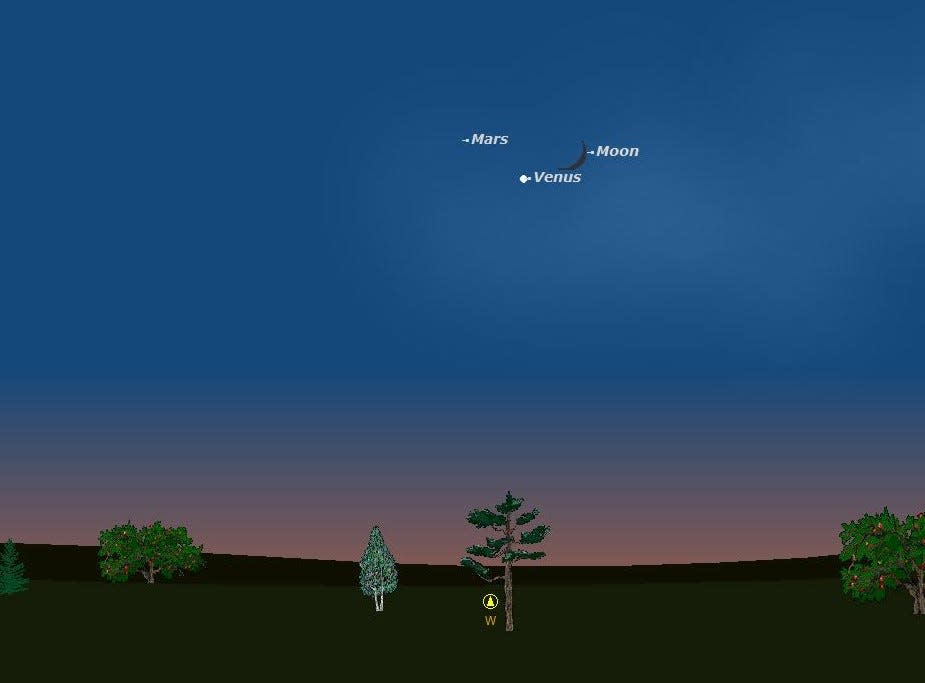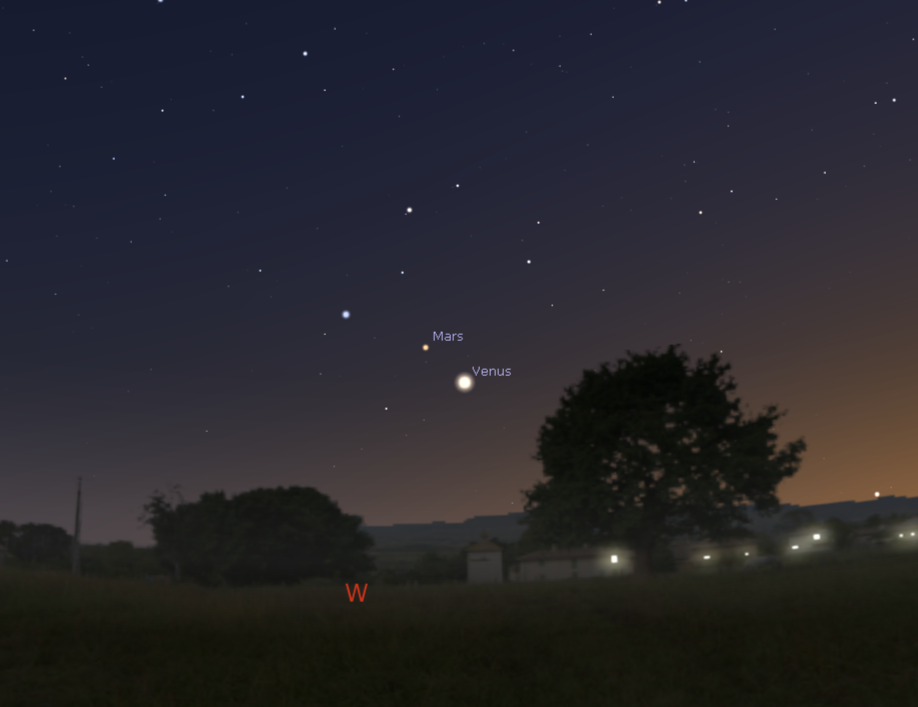Sky Shorts: Venus is the jewel in the evening sky

The dazzling gem Venus will put on its best show of the year in June! Venus is visible, in the western sky, more than three hours after sunset, so its brilliance will capture your attention. Venus has been a delight for the last several months. It paired with bright Jupiter in early March, passed by the lovely star cluster the Pleiades in April and paired with the crescent Moon several times. On June1, Venus lines up with Castor and Pollux, the two stars in Gemini, the Twins. On June 12 and 13 it will arrive within one degree of the Beehive star cluster. Then on the Summer Solstice, June 21, Venus will put on a stunning show with the crescent Moon with Mars and the Beehive star cluster nearby. Venus will conclude the month less than 4 degrees from Mars.
On June 4, Venus will reach greatest eastern elongation at 45 degrees from the Sun. This explains why Venus sparkles well after sunset. Venus is the third brightest object in the sky, with the Sun first and the Moon second.
On June 1, Venus is 67.8 million miles from Earth and 46.3 million miles by June 30. It will start the month at magnitude -4.4 and brighten to magnitude -4.7 by June 30.
Venus’ brilliance is due in part to its highly reflective clouds. These clouds contain droplets of sulfuric acid as well as acidic crystals that light bounces off easily. Another factor also contributes to Venus’ brightness. It is called albedo which describes how bright a planet is in absolute terms. Planets in our solar system do not make their own light but instead reflect the Sun’s light. When sunlight hits a planet, the surface absorbs some light and reflects the rest.
Albedo is the comparison between how much light hits an object and how much light the object reflects. Of the major planets in our solar system, Venus has the highest albedo! Reflecting 70% of the sunlight striking it, makes Venus’ albedo .7. Our Moon, at full phase, reflects only 10% of the light that strikes it due to the dark volcanic rock on the surface. But the Moon is much closer to Earth than Venus. The only object that has a higher albedo than Venus, is Saturn’s moon Enceladeus, which is 90%.
Venus also brightens when it passes between Earth and the Sun, but not at that exact point. Venus is an inferior planet, so its orbit is inside Earth’s orbit around the Sun. When it hits the exact point between the earth and the Sun, we are looking at the side of Venus that is not illuminated or facing the Sun. We call this inferior conjunction. Venus is at its brightest just before or just after inferior conjunction. Inferior planets also go through phases. What is interesting is that Venus is a crescent phase before and after inferior conjunction. But it is getting close to Earth, so the disk gets larger, so the greatest amount of surface area is visible in our sky. This is called greatest illuminated extent.
Venus will depart from our evening sky in late July and return to the morning sky. On September 19, Venus will achieve maximum brilliancy at magnitude -4.8. Now is the time to enjoy that gem in the evening sky!

Night Sky for June
Ten months until the Total Solar Eclipse!
Planets and the Moon
Venus will be the showstopper all month! Towards month’s end, crescent Venus will be large enough to view in binoculars, especially in bright twilight. Mars will continue to fade in brightness and Venus will close in on Mars throughout the month.
On June 1, Mars is 10 degrees to the upper left of Venus, the gap closes to seven degrees on June 7-8. On June 19, Mars is five degrees west of Venus and on June 30 the least separation will be less than four degrees. On June 1-2, Mars will be nestled among the stars of the Beehive star cluster. Binoculars provide a great view, but the telescopic view is beautiful. Saturn rises at 1:30 a.m. June 1 and is well above the horizon by midnight at month’s end. Saturn is the brightest object between the Square of Pegasus and the bright star Formalhaut. Jupiter rises just before 4 a.m. on June 1 and about two hours earlier on June 30. Its magnitude is -2.2, so it is easy to spot over the eastern horizon before sunrise. Neptune is 20 degrees above the eastern horizon at the beginning of June. It lies about 20 degrees east of Saturn in southwestern Pisces. Binoculars are needed. Uranus also requires binoculars and is located 16 degrees east of Jupiter in the constellation Aries, the Ram. On June 1, Mercury rises less than an hour after Jupiter and can be found 13 degrees east of the king of the planets. Mercury’s magnitude increases through mid-month, but the planet is so low it is a challenge to spot. Late in the month it disappears from view.

Constellations:
West – The two stars that look identical, Castor and Pollux, are part of Gemini, the Twins. The star Capella, is to the right of Gemini and the star Procyon, is to the left of Gemini. Above Gemini you will see the shape of a backward question mark, which is the head of Leo, the lion.
North – The Big Dipper is high in the sky. Following the two stars at the end of the cup to the next bright star, Polaris, or the North Star. The constellation Cassiopeia, the “W” shape is below Polaris.
East – Head back to the cup of the Big Dipper. Now, arc off the handle of the Big Dipper to the bright yellow, orange star Arcturus. Look right for the bright blue, white star, Spica. Just below Arcturus, is a semi-circle of stars, the Northern Crown or Corona Borealis. Continue down and to the left, you will see a keystone or crooked square shape, which is the body of Hercules. The bright blue, white star down and to the left is Vega, which is part of the Summer Triangle. To the right of Hercules is a red, orange star, Antares, which is the heart of Scorpius.
Binocular Highlights – In the western sky, scan up and left of Gemini, the twins. There you will find the Beehive Star Cluster. Continue to scan, up through the head of Leo (backward question mark). Halfway to the bright star Arcturus you will see another star cluster, Coma Berenices. Find Hercules and scan around the part of Hercules that faces Corona Borealis. You will see a fuzzy object which is the finest globular star cluster in the northern skies!
For further night sky details, maps and audio, visit my website www.starrytrails.com.
Visit Hoover Price Planetarium – Starting May 30, 2023, there will be daily planetarium shows Tuesday – Saturday. Visit www.mckinleymuseum.org, for show dates and times! Planetarium shows are free with Museum admission. The Planetarium is located inside the McKinley Presidential Library & Museum, 800 McKinley Monument Drive, N.W., in Canton, Ohio. For more information, please call the Museum at 330-455-7043.

This article originally appeared on The Repository: Sky Shorts: Venus is the jewel in the evening sky

